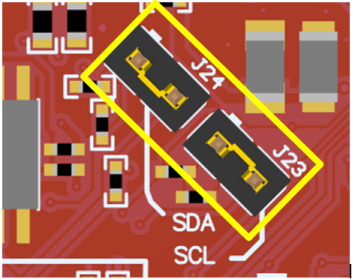SWRU548C February 2019 – September 2021 CC3235MODAS , CC3235MODASF , CC3235MODS , CC3235MODSF
- 1Introduction
-
2Hardware
- 2.1 Block Diagram
- 2.2
Hardware Features
- 2.2.1 Key Benefits
- 2.2.2 XDS110-Based Onboard Debug Probe
- 2.2.3 Debug Probe Connection: Isolation Jumper Block
- 2.2.4 Application (or "Backchannel") UART
- 2.2.5 JTAG Headers
- 2.2.6 Using the XDS110 Debug Probe with a Different Target
- 2.2.7 Power Connections
- 2.2.8 Reset Pullup Jumper
- 2.2.9 Clocking
- 2.2.10 I2C Connection
- 2.2.11 Sense on Power (SOP)
- 2.2.12 Push-Buttons and LED Indicators
- 2.3 Electrical Characteristics
- 2.4 Antenna Characteristics
- 2.5 BoosterPack Plug-in Module Pinout
- 3Layout Guidelines
- 4Operational Setup and Testing
- 5Development Environment Requirements
- 6Additional Resources
- 7Assembly Drawing and Schematics
2.2.10 I2C Connection
The board features an accelerometer and a temperature sensor for the out-of-box demo. These are connected to the I2C bus, and can be isolated using the jumpers provided (shown as yellow jumpers J23 and J24 in Figure 2-12).
 Figure 2-12 I2C Connections
Figure 2-12 I2C Connections
By removing J23 and J24, the accelerometer and the temperature sensors are isolated from the I2C bus. This measure also removes the I2C pullup resistors from the sensor side of the circuit, and therefore any connection to the circuit requires the user to install external pullup resistors.
Table 2-4 lists the I2C jumper definitions.
Table 2-4 I2C Jumper Definitions
| Reference | Use | Comments |
|---|---|---|
| J23 | I2C SCL | Populated: CC3235MOD SCL connected to onboard sensors with pullup |
| Open: CC3235MOD SCL disconnected from onboard sensors | ||
| J24 | I2C SDA | Populated: CC3235MOD SDA connected to onboard sensors with pullup |
| Open: CC3235MOD SDA disconnected from onboard sensors |